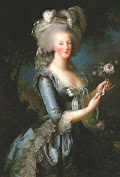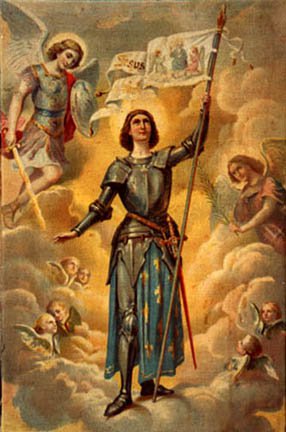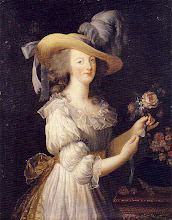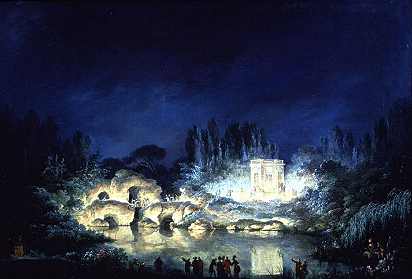
While
famine is one recurring theme in classic fairy-tales, another is
giants. Giants who terrorize and prey upon peasants appear again and again in the tales that have been passed down to us, the most popular being the story of "
Jack and the Beanstalk." Other famous giant stories are
"Jack the Giant-Killer," "The Brave Little Tailor" and "
Tom Thumb." According to
The Oxford Companion to Children's Literature:
One of the oldest printed fairy tales in England was Tom Thumb which appeared in 1621 in a chapbook. Chapbooks were works of popular literature sold for a few pence by pedlars or ‘chapmen’ from the 16th to the 19th cent. In 1711 there appeared the first printed version of Jack the Giant Killer, a popular English folk tale.
Tom Thumb is born in answer to the wish of a childless poor couple, who desire a son even if he should be no bigger than his father’s thumb. Magician Merlin answers their wish and the Fairy Queen names him and gives him a hat made of oak leaf and a shirt of spider’s web. Tom then encounters many adventures. The last of them is being eaten by a fish which is then caught for King Arthur’s table; Tom becomes a knight and when he dies is mourned by the whole Arthur’s court.
Jack the Giant Killer is a story of witty and ingenuous Jack, the only son of a Cornish farmer. He decides to destroy a giant terrorizing Cornwall. Armed with horn, shovel and pick-axe, at night he digs a pit outside the giant’s cave. Then he wakes the giant with a blast on the horn and after the giant falls into the trap he kills him with his pick-axe. As a reward he gets the giant’s treasure and the title ‘the Giant Killer’. He continues in the same style and kills two more giants; he also helps king Arthur’s son to marry a lady of his heart and becomes a knight of the Round Table. In the second part he sets out to rid country of all giants and monsters and finally to release a duke’s daughter whom he then marries and lives happily with on an estate given to him by the king. From this fairy are the words ‘Fe, fi, fo, fum, I smell the blood of an Englishman’, uttered by a giant who can’t see Jack who is wearing a coat of darkness he got from another giant together with a cap of knowledge, a never-failing sword and shoes of swiftness.
However, most fairy tales circulated in England only in oral form. Puritan writers, who were the first to write for children, considered tales about magical wonders inappropriate for children; John Bunyan, author of The Pilgrim’s Progress, regretted a childhood spent reading chapbook stories about marvellous happenings and in New England in America another writer, Cotton Mather, complained of ‘foolish Songs and Ballads’ on such fanciful subjects and recommended writing ‘poetical compositions full of Piety’.
In the 18th century English translations of French fairy tales mainly by Perrault were published in England and from the beginning of the 19th century also English folk fairy tales started to appear in print, e.g. Jack and the Beanstalk.
Jack and the Beanstalk is a story of lazy Jack, the only child of a poor widow. When she sends him to the market to sell her cow, he returns with a handful of beans instead of money. She throws the beans away and in the morning there is a huge beanstalk in the garden. Jack climbs to its top and finds there a barren land. He meets a fairy who tells him that nearby lives a giant who deceived and killed Jack’s father years ago. Jack goes to the giant’s house where he is given food and drink by his wife who then hides him in the oven. When the giant returns home and falls asleep Jack steals his hen which can lay golden eggs, climbs down the beanstalk and gives the hen to his mother. Later he makes two more journeys up the beanstalk and gets back with the giant’s money-bags and a magic harp. When stealing the harp it starts speaking so the giant wakes up and chases Jack; when he starts climbing down the stalk, Jack cuts it so that the giant falls down and is killed by the fall.
Around the middle of the 19th century J. O. Halliwell and Robert Chambers collected fairy tales, the latter in Scotland. In 1890 were published English Fairy Tales collected by Joseph Jacobs, followed by more collections of this editor.
The history behind the giant stories has always intrigued me. Were the giants a figurative way of describing baronial tyrants or thuggish robbers? Or were there really persons of extraordinary height who used their superior physical strength to bully everyone else? Sacred Scripture certainly has several mentions of giants, Goliath being one of the most notorious. In European folklore, giants are usually seen as being the remnant of a former civilization. Most of the giant stories which involve a youth named "Jack" are usually set in either Cornwall or Wales and appear to have some connection with the larger cycle of Arthurian legend. It must be noted, however, that Jack himself is not mentioned in the early tales. As Thomas Green states in The Arthuriad:
The curious thing about Jack is that – in contrast to that other fairy-tale contemporary of King Arthur's, Tom Thumb – there is no trace of him to be found before the early eighteenth century. The first reference to him comes in 1708 and the earliest known (now lost) chapbook to have told of his deeds was dated 1711.... If Jack was a literary creation – rather than a genuine figure of folk-tale – whose tale was woven from earlier non-Jack giant-killings and traditions, this naturally raises some intriguing questions about the origins of both these stories of Welsh and Cornish giants and the actual concept of Jack as the hero who finally rids Britain of these creatures. With regards to this, it is important to note the presence of King Arthur throughout Jack‘s tale....
The solution, as I have argued elsewhere, may well lie with Arthur‘s well-documented role as the slaughterer of British giants through a combination of extreme violence, cunning and trickery....In fact, in Welsh and Cornish folklore of the sixteenth to nineteenth centuries it is repeatedly claimed that Arthur was the greatest of all giant-killers, responsible for finally ridding the land of giants....
In Arthur we have a figure of genuine folklore and early British story who parallels and pre-dates Jack in both his role and the type of deeds that are ascribed to him....Jack was a new final vanquisher of the giants of Britain, designed for an England that was interested such folkloric tales but which would appear to have become bored of Arthur himself by the early eighteenth century....
This is not, of course, to say that a knowledge of the Arthurian tradition fully explains Jack‘s History... but rather to suggest that The History of Jack and the Giants deserves to be considered as a genuine part of the development of the Arthurian legend, not simply an unrelated fairy tale that happens to be set in the reign of King Arthur as a variant of 'Once upon a time.'
Perhaps we will never know exactly why "Jack" came to replace King Arthur as the slayer of giants in the popular mind. Maybe those who printed the chapbooks in seventeenth century England saw that Jack, a poor boy who, in spite of poverty, destroys a formidable aggressor, would have a more general, and highly marketable, appeal. At any rate, the various versions of the story of Jack and his giant opponent still resonate with us today.

(Artwork courtesy of
Hermes)
Share




































